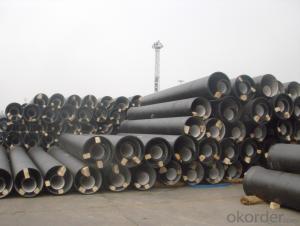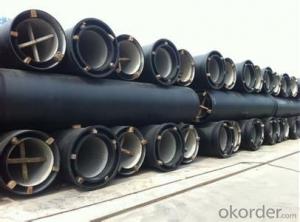DUCTILE IRON PIPES K9 DN80
- Loading Port:
- China Main Port
- Payment Terms:
- TT OR LC
- Min Order Qty:
- -
- Supply Capability:
- -
OKorder Service Pledge
OKorder Financial Service
You Might Also Like
Ductile Iron Cast Pipe is without any defects compare with tradition casting tech, which has many advantages particularly as follow:
(1) High density. In the "vertical upward casting" process, the melt iron of centre liquid column in center crystallizer is continuously feeding for volume shrinkage caused by condensation tube at outer circumference , which lead to be free of shrinkage porosity.
(2) High purity. When melt iron pouring, the mixed impurities such as gas, dross, sand grain which are lighter than melt iron could be eliminated at furnace mouth, its impossible to enter into the crystallizer through the channel, so the melt iron into the crystallizer is very pure.
(3) Strength with toughness. The cooling speed provided by continuous crystallizer is 30 times than sand casting and 5 times than centrifugal casting, and doesn't produce white iron, the eutectic cell volume of continuous cast iron is one eighth to one tenth compare with traditional cast iron. The density of graphite nodule in ductile iron can reach 300-700 pcs/mm2. Therefore, all reason above improve the strength and toughness of continuous cast iron.
(4) Free machining. The high speed cooling make the hardening phase (such as boride, steadite) not appear like reticular, massive or thick, but diffuse like fish bone and pane in shape, moreover, there are tiny graphite flakes inlaid hardening phase. It's free machining in BrinellHardness the range of 250-300HB. However, the Brinell Hardness of 250 is top limit to common metal materials.
(5) Uniform composition of tube wall. The convection mixing of liquid column caused by marching type drawing in crystallizer make the composition of tube wall well-distributed, and concentration gradient very little.
(6) High productivity. To the wall thickness of tube under 10mm, the speed of continuous casting is 1 meter/min, to the wall thickness of tube under 20mm, the speed of continuous casting is 0.5 meter/min, which is high efficiency that centrifugal or other casting tech couldn't reach.
- Q:What are the typical joint restraint systems used in ductile iron pipes?
- Ductile iron pipes commonly employ various joint restraint systems, including mechanical joint restraints, push-on joint restraints, and restrained joint systems. 1. Mechanical Joint Restraints: These systems secure pipe joints using mechanical devices. The gland-type restraint, consisting of a gland and follower, is the most prevalent. By placing the gland over the pipe joint and tightening it with bolts, a tight seal is created, preventing movement. 2. Push-On Joint Restraints: Rubber gaskets are utilized in push-on joint restraints to establish a watertight seal between pipe sections. These restraints do not require additional devices or bolts to secure the joint. The gasket generates enough friction and compression to prevent pipe separation. 3. Restrained Joint Systems: These systems offer enhanced joint integrity and resistance to longitudinal movement. Typically, they combine mechanical joint restraints and push-on joint restraints. Additional elements like harnesses, rods, or wedges may also be incorporated for additional support and prevention of joint separation. It is crucial to consider that the specific joint restraint system employed in ductile iron pipes may vary based on factors such as application, pipe diameter, and operating conditions. Selecting the appropriate joint restraint system is vital to ensure the pipeline's structural integrity and longevity.
- Q:What are the different types of ductile iron pipe joints?
- Various applications commonly utilize different types of ductile iron pipe joints to ensure efficient fluid transfer and prevent leaks. These joints provide strong and reliable connections between pipes. Some of the most frequently used types of ductile iron pipe joints are as follows: 1. Push-on Joint: This joint is simple to install and does not require any special tools. The spigot end of one pipe is inserted into the bell end of another pipe, creating a tight seal. A rubber gasket is typically used to enhance leak resistance. 2. Mechanical Joint: Water and wastewater applications often use mechanical joints. They consist of a gland, a rubber gasket, and a follower gland. The pipe ends are pushed into the gland, and the follower gland is tightened, compressing the rubber gasket and establishing a secure connection. 3. Restrained Joint: These joints are designed to withstand high internal and external forces, such as water pressure or soil loadings. Rubber gaskets and restraining mechanisms like bolts or wedges are commonly used to prevent pipe movement or separation under stress. 4. Flanged Joint: Large diameter pipes or applications requiring frequent disassembly often employ flanged joints. Each pipe end is equipped with a flange, which is then bolted together with gaskets to create a strong connection. Flanged joints provide convenient access for maintenance or repairs. 5. Welded Joint: Welded joints involve heating and fusing the pipe ends to form a permanent connection. This type of joint is typically used in high-pressure applications where a reliable and leak-free connection is crucial. Skilled labor and specialized equipment are required for welded joints. To ensure the integrity and longevity of the ductile iron pipe system, it is important to choose the appropriate joint based on the specific application, pipe size, and operating conditions. Consulting with a professional engineer or pipe manufacturer can help determine the most suitable joint for a particular project.
- Q:How does ductile iron pipe compare to steel pipe in terms of durability?
- Ductile iron pipe is generally considered to be more durable than steel pipe. It has superior strength and durability due to its unique microstructure, which allows it to withstand higher levels of pressure, impacts, and loads. Ductile iron pipe also has better corrosion resistance properties, making it less prone to rust and deterioration compared to steel pipe. Additionally, ductile iron pipe has a longer lifespan and requires less maintenance, making it a more reliable and durable choice for various applications.
- Q:Can ductile iron pipe be used for municipal water supply?
- Yes, ductile iron pipe can be used for municipal water supply. Ductile iron pipe has excellent strength and durability, making it suitable for carrying the high-pressure water supply required for municipal systems. Additionally, its corrosion resistance and long lifespan make it a reliable choice for transporting water in urban areas.
- Q:Can ductile iron pipes be used for irrigation pivot systems?
- Yes, ductile iron pipes can be used for irrigation pivot systems. Ductile iron pipes have high tensile strength and durability, making them suitable for handling the pressure and load requirements of irrigation pivot systems. Additionally, their corrosion resistance makes them a reliable choice for long-term use in such applications.
- Q:How does ductile iron pipe perform in areas with high soil consolidation?
- Ductile iron pipe performs well in areas with high soil consolidation due to its inherent strength and durability. The pipe's flexibility allows it to withstand ground movement, settlement, and consolidation without compromising its structural integrity. Additionally, ductile iron is resistant to corrosion, making it a suitable choice for areas with varying soil conditions.
- Q:Can ductile iron pipes be used for underground storage tanks?
- No, ductile iron pipes are not suitable for underground storage tanks. Underground storage tanks usually require special materials that have corrosion resistance and can withstand the pressure and environmental conditions.
- Q:How does ductile iron pipe perform in areas with high soil corrosivity?
- Due to its inherent corrosion-resistant properties, ductile iron pipe exhibits exceptional performance in areas with high soil corrosivity. The material specifically utilized in ductile iron pipes is engineered to endure harsh soil conditions, including those with elevated levels of corrosive elements. The protective coating is one of the key factors making ductile iron pipe suitable for areas with high soil corrosivity. Most ductile iron pipes are coated with either a layer of cement mortar or a polyethylene sleeve, which acts as a barrier separating the soil from the pipe. This coating serves the dual purpose of preventing direct contact between the soil and the iron, as well as providing an additional layer of defense against corrosion. Moreover, ductile iron possesses inherent corrosion resistance. It contains a higher carbon percentage compared to traditional cast iron, enhancing its strength and durability. The carbon content also generates a protective layer of graphite within the iron matrix, acting as a natural barrier against corrosion. Ductile iron pipes have demonstrated a long service life in areas with high soil corrosivity, often surpassing 100 years. This is due to their ability to withstand corrosion and maintain structural integrity even in harsh environments. Additionally, ductile iron pipes exhibit high resistance to external loads and can endure the stresses associated with high soil corrosivity. In summary, ductile iron pipe is an exceptional choice for areas with high soil corrosivity. Its corrosion-resistant properties, coupled with protective coatings, guarantee the pipe's durability and reliability, even under the most challenging soil conditions.
- Q:What do ductile iron pipes need to connect with three? Can I contact it directly?
- Because the interface material used in the old process is poisonous, especially in the water supply pipeline, environmental protection requires a new process now
- Q:Are ductile iron pipes suitable for use in hydroelectric dams?
- Yes, ductile iron pipes are suitable for use in hydroelectric dams. They offer high strength, durability, and corrosion resistance, making them ideal for the harsh conditions found in dam environments. Additionally, ductile iron pipes have excellent hydraulic properties and can handle high water pressure, making them a reliable choice for transporting water in hydroelectric dams.
1. Manufacturer Overview |
|
|---|---|
| Location | |
| Year Established | |
| Annual Output Value | |
| Main Markets | |
| Company Certifications | |
2. Manufacturer Certificates |
|
|---|---|
| a) Certification Name | |
| Range | |
| Reference | |
| Validity Period | |
3. Manufacturer Capability |
|
|---|---|
| a)Trade Capacity | |
| Nearest Port | |
| Export Percentage | |
| No.of Employees in Trade Department | |
| Language Spoken: | |
| b)Factory Information | |
| Factory Size: | |
| No. of Production Lines | |
| Contract Manufacturing | |
| Product Price Range | |
Send your message to us
DUCTILE IRON PIPES K9 DN80
- Loading Port:
- China Main Port
- Payment Terms:
- TT OR LC
- Min Order Qty:
- -
- Supply Capability:
- -
OKorder Service Pledge
OKorder Financial Service
Similar products
New products
Hot products
Related keywords



























